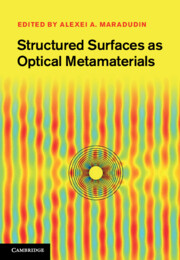Book contents
- Frontmatter
- Contents
- List of contributors
- Preface
- 1 Physics of extraordinary transmission through subwavelength hole arrays
- 2 Resonant optical properties of nanoporous metal surfaces
- 3 Optical wave interaction with two-dimensional arrays of plasmonic nanoparticles
- 4 Chirality and anisotropy of planar metamaterials
- 5 Novel optical devices using negative refraction of light by periodically corrugated surfaces
- 6 Transformation of optical fields by structured surfaces
- 7 Surface electromagnetic waves on structured perfectly conducting surfaces
- 8 Negative refraction using plasmonic structures that are atomically flat
- 9 Anomalous transmission in waveguides with correlated disorder in surface profiles
- 10 Cloaking
- 11 Linear and nonlinear phenomena with resonating surface polariton waves and their applications
- Index
- Plate section
- References
10 - Cloaking
Published online by Cambridge University Press: 01 June 2011
- Frontmatter
- Contents
- List of contributors
- Preface
- 1 Physics of extraordinary transmission through subwavelength hole arrays
- 2 Resonant optical properties of nanoporous metal surfaces
- 3 Optical wave interaction with two-dimensional arrays of plasmonic nanoparticles
- 4 Chirality and anisotropy of planar metamaterials
- 5 Novel optical devices using negative refraction of light by periodically corrugated surfaces
- 6 Transformation of optical fields by structured surfaces
- 7 Surface electromagnetic waves on structured perfectly conducting surfaces
- 8 Negative refraction using plasmonic structures that are atomically flat
- 9 Anomalous transmission in waveguides with correlated disorder in surface profiles
- 10 Cloaking
- 11 Linear and nonlinear phenomena with resonating surface polariton waves and their applications
- Index
- Plate section
- References
Summary
Introduction, general background, and history
Cloaking is the ability to make a region of space, and everything in it, invisible to an external observer. It has been the dream of fantasy writers for decades. In 2009, John Mullan [1] of The Guardian newspaper summarized the ten most important works that use the theme: The Invisible Man by H. G. Wells, The Republic by Plato, The Lord of the Rings by J. R. R. Tolkien, the Harry Potter books by J. K. Rowling, Theogony by Hesiod, Dr Faustus by Christopher Marlowe, The Tempest by William Shakespeare, The Voyage of the Dawn Treader by C. S. Lewis, The Emperor's New Clothes by Hans Christian Andersen, and The Hitchhiker's Guide to the Galaxy by Douglas Adams. A true cloak allows the clear observation of the space behind the cloaked region, and the cloaked region casts no shadow and produces no wavefront changes in the light that has passed through the cloaked region. It is not possible to build a perfect invisibility cloak, as was perceptively observed in the Star Trek series in which cloaked Romulan and Klingon spaceships could be detected by the subtle disturbances of space that the cloak produced.
Interest in making real cloaking devices can be traced to two seminal articles, one by John Pendry and his co-workers [2], and the other by Ulf Leonhardt [3]. Their approach can be called the transformational optics approach to cloaking, which will be discussed in more detail later.
- Type
- Chapter
- Information
- Structured Surfaces as Optical Metamaterials , pp. 316 - 385Publisher: Cambridge University PressPrint publication year: 2011

